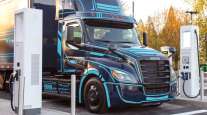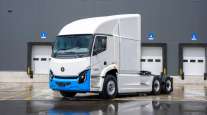President and CEO, Transervice Logistics Inc.
Perspective: How Fleets Can Prepare for EVs
[Stay on top of transportation news: Get TTNews in your inbox.]
There are so many developments occurring in the electric vehicle space that it is becoming hard to keep up. But before fleets rush out to invest in battery-electric trucks, there are important things that need to be taken into account — and not all of the considerations are obvious at first glance. Fleets interested in EVs need to start preparing now.
If you’re a fleet considering taking the dive into electric vehicles, now is a good time to start meeting with local utility companies to discuss the implications. What changes will you need to make to the electric service at your locations? How much lead time is there to get an electric vehicle charger installed? How prepared is your utility to help you navigate the move to BEVs? Some utilities have staff dedicated to helping fleets electrify, others do not yet have plans in place. Before you get too deep into vehicle electrification, it will be useful to know how helpful your local utilities will be.
We all need to start thinking about the maintenance needs of these vehicles as well. While it is estimated that BEVs will need less maintenance because they will have fewer moving parts, we still have to understand what the maintenance needs are, what diagnostic tools are required and what type of training is needed to develop for our technicians. And most importantly, what are the safety precautions we will have to implement in our shops to protect our technicians from the high voltage of these vehicles? Finally, is your current technician staff equipped to train on these new types of vehicles? Or, if you outsource, is a third-party provider ready as well?

Nierenberg
Another challenge with any new technology is predicting the useful life and expected residual value at the end of the vehicles’ anticipated operating term. Having a realistic idea of what the residual value will be is important in both the financing of the asset and in determining the asset’s total cost of ownership.
Battery life will play a role in those values. Right now, OEMs are able to provide some visibility to the useful life of batteries based on limited applications and weather conditions. However, there is still significant uncertainty. As such, carriers will need to be comfortable taking on some additional risk as to how long batteries will last. As it relates to the residual value of the BEV (and more specifically the battery), it is too early to assess. There is some speculation that used batteries will maintain some type of value in recycling, but it’s just too soon to predict. Carriers will really need to be willing to take the risk on both the useful life and residual value as they begin to implement BEVs into their fleets.
Fleets must also consider vehicles’ duty cycles, and recognize there are some where BEVs make good sense. For fleets in shorthaul and local delivery applications, for example, now is a good time to start limited investing in BEVs; longhaul carriers may be in for a longer wait. Cost is also going to be a major factor for many fleets. Right now, a battery-electric commercial vehicle will cost significantly more than its diesel-powered counterpart. There are government incentives to compel investment in BEVs and help offset the costs, but those are unlikely to be a viable long-term strategy. BEVs eventually must achieve cost parity with diesels. Meantime, fleets must be realistic about their funds — with or without government incentives.
Another big hurdle to widespread BEV adoption is lack of charging infrastructure. As of today, there is no coast-to-coast charging infrastructure in place. While some government subsidies are available for investment in charging infrastructure, it is capital intensive. And the lack of broad charging infrastructure creates challenges for the majority of trucking applications. However, billions of dollars in the Biden administration’s infrastructure bill have been designated for investment in alternative power.
New technologies are cool and exciting, and it’s easy to get caught up in the hype. Battery-electric vehicles will be part of trucking’s future, but we need to play the long game and take a measured approach to deploying them to ensure success.
Transervice Logistics Inc. provides customized transportation solutions including logistics, dedicated contract carriage, fleet leasing, contract maintenance, and material handling equipment leasing and maintenance.
Want more news? Listen to today's daily briefing below or go here for more info:




